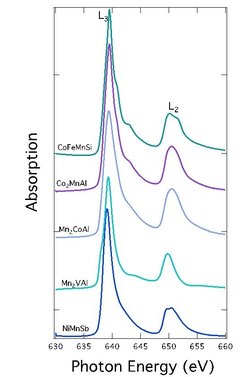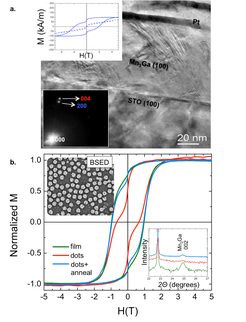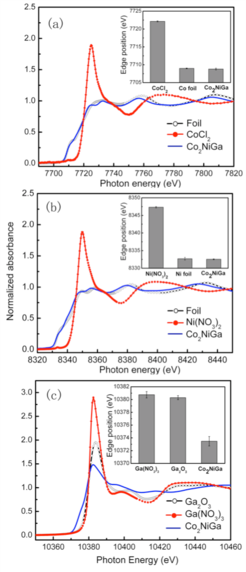Mn2-based Compounds
Our work seeks to design and control the magnetic and electronic properties of materials, which allow the discovery of new physics and enable future device applications. X-ray absorption spectroscopy (XAS) and X-ray magnetic circular dichroism (XMCD) are powerful techniques that can be used to probe the magnetic and electronic states in materials. They are utilized extensively in our group to probe bulk, thin film and nanostructures of Heusler compounds and transition metal oxides with strongly correlated electrons.
Simple Rules for Designing Mn-based Heusler Compounds for Spintronics

Fig. 1: Mn L-edge absorption for selected Heusler compounds.
Mn-based Heusler compounds are perhaps some of the most attractive compounds for future spintronics applications. For instance, Mn3Ga has been proposed as a potential material for spin transfer torque devices. Here, Mn is present on multiple sublattices, and the magnetic moments are antiparallel, guaranteeing a low total moment with a high Curie temperature. Additionally, Mn when coordinated octahedrally by Si in Co2MnSi leads to full spin-polarization of the charge carriers and consequently widespread applicability as an electrode material in tunneling magnetoresistance (TMR) devices.
These materials are highly tunable, due in part to the large number of different elements that can be used to form the ternary compounds on a relatively simple lattice with high symmetry, which, in the chemical sense, contains multiple sublattices. Designing new materials for future device applications necessitates a general understanding of how Mn behaves on the individual chemical sublattices. We therefore probed the electronic and magnetic properties of Mn as a function of coordination with respect to Z in full and half Heusler compounds experimentally using X-ray absorption spectroscopy (XAS) and X-ray magnetic circular dichroism (XMCD) and theoretically with ab initio calculations (Fig. 1). Both theory and experiment show that the Mn oxidation state indicates delocalized metallic-like behavior in the full and half Heusler compounds. However, the magnetic moment in the octahedral sites is large and localized (atomic-like), but the moment in the tetrahedral sites is reduced. These general rules can be used to tailor the magnetic and electronic properties for future applications in Mn-based Heusler compounds by carefully controlling the individual sublattices.
MnxGa1-x Thin Films and Nanodots with High Coercivity and Perpendicular Magnetic Anisotropy

Fig. 2: (a) Cross sectional HRTEM image from the x=0.75, 350oC sample. The bottom inset shows a portion of the FFT in the film region. The top inset shows in-plane (dashed) and out-of-plane (solid) magnetization. (b) M(H) for Mn70Ga30 film and nanodots before and after annealing. The bottom inset shows an XRD pattern of the same samples. The top inset shows an SEM image of the nanodots.
Single Phase Co2NiGa Nanoparticles for Nanoscale Devices

We fabricated for the first time Co2NiGa nanoparticles (NPs) of a single γ-phase (γ-Co2NiGa). The NPs were prepared by impregnation in colloidal silica followed by high temperature annealing. Energy dispersive X-ray spectroscopy mapping and X-ray absorption near edge structure data provided evidence for the successful preparation of the intermetallic NPs and the absence of impurity phases. Extended X-ray absorption fine structure spectroscopy data confirm the formation of the γ-Co2NiGa phase by examining the atomic environments surrounding Co, Ni, and Ga (Fig. 3). The Co2NiGa NPs were ferromagnetic with a high saturation magnetization. γ-Co2NiGa NPs exhibited a very high Curie temperature (≈ 1139 K), which make them promising candidates for high temperature magnetically activated nanoscale devices.


